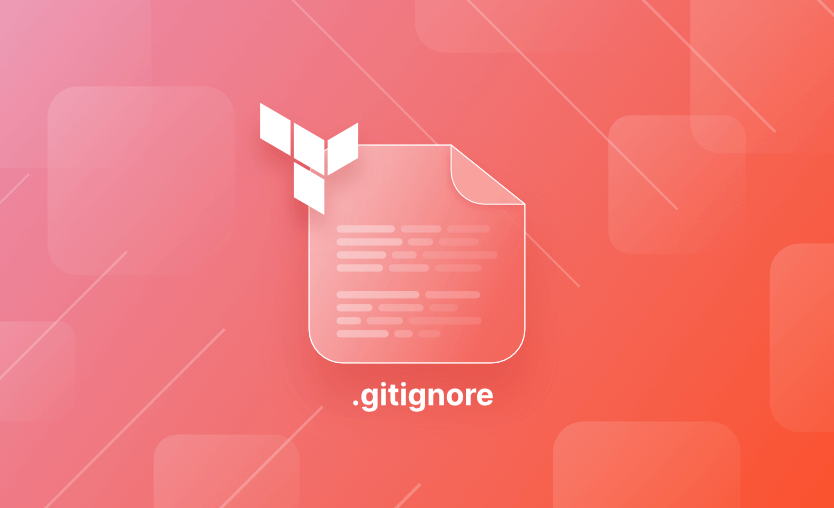In this short article, we will take a look at gitignore, explaining what it is and why you might want to use it. We will show some useful examples and practical files you can use with your Terraform projects!
What is gitignore?
A .gitignore file is a text file used by Git to specify files and directories that should be ignored and not tracked by the version control system (VCS). Git itself is a distributed version control system (VCS) that helps developers track changes, collaborate on projects, and manage source code efficiently and has become the standard for version control.
When you create a .gitignore file and add patterns to it, Git will disregard those files and directories when you perform operations like staging, committing, and pushing changes to a repository.
Note that .gitignore files are not specific to Terraform projects, they can be used wherever Git is used with your VCS.
How to use the .gitignore file with Terraform
To use a .gitignore file with Terraform, simply create a new text file and name it .gitignore — place this file in the root directory of your project.
Step 1 – Go to bash terminal
To do this on the command line, go to bash terminal and create a new file using touch .gitignore .
Step 2 – Run git init and terraform init
You should also run the git init and terraform init commands to initialize your project.
Step 3 – Create the .gitignore file
You can add the sections of code as shown below as needed to form your .gitignore file. Once the file is pushed to your repository, from that point on the files and paths listed in your .gitignore file will be ignored.
Step 4 – Ignore local Terraform directories and files
Local Terraform directories and environment-specific files contain runtime information from execution done on the local machine and, therefore, do not need to be committed to source control.
# Local .terraform directories
**/.terraform/*
# Ignore variables files
*.auto.tfvars
# Ignore override files
*.tfoverride
# Ignore environment-specific files
.envrc
# Ignore CLI configuration files
.terraformrc
terraform.rcStep 5 – Ignore Terraform state files
Terraform state files will constantly be updated on each terrafom plan and terraform apply and so should be excluded from the VCS.
# .tfstate files
*.tfstate
*.tfstate.*Step 6 – Ignore log files
Crash logs generated from local executions don’t need to live in the VCS.
# Crash log files
crash.log
crash.*.logStep 7 – Ignore sensitive data
Sensitive files like encryption keys should never be committed to source control!
# Ignore sensitive files
*.pem
*.key
*.pubRead more about Terraform secrets.
Full .gitignore file example
This example is based on the code from the GitHub link here.
# Local .terraform directories
**/.terraform/*
# .tfstate files
*.tfstate
*.tfstate.*
# Crash log files
crash.log
crash.*.log
# Exclude all .tfvars files, which are likely to contain sensitive data, such as
# password, private keys, and other secrets. These should not be part of version
# control as they are data points which are potentially sensitive and subject
# to change depending on the environment.
*.tfvars
*.tfvars.json
# Ignore override files as they are usually used to override resources locally and so
# are not checked in
override.tf
override.tf.json
*_override.tf
*_override.tf.json
# Include override files you do wish to add to version control using negated pattern
# !example_override.tf
# Include tfplan files to ignore the plan output of command: terraform plan -out=tfplan
# example: *tfplan*
# Ignore CLI configuration files
.terraformrc
terraform.rcKey points
You can use a .gitignore file in any Git-controlled repository to exclude files and folders that you don’t want to commit to source control. These might include sensitive files, files that apply to local usage only, or files that are necessary to commit to the repository. The example above can be used to form the basis of your .gitignore file for your Terraform projects.
We encourage you also to explore how Spacelift makes it easy to work with Terraform. If you need any help managing your Terraform infrastructure, building more complex workflows based on Terraform, and managing AWS credentials per run, instead of using a static pair on your local machine, Spacelift is a fantastic tool for this.
Manage Terraform Better and Faster
If you are struggling with Terraform automation and management, check out Spacelift. It helps you manage Terraform state, build more complex workflows, and adds several must-have capabilities for end-to-end infrastructure management.
Git. gitignore Documentation. Accessed: 21 October 2025
Atlassian Git Tutorial. .gitignore file – ignoring files in Git. Accessed: 21 October 2025
